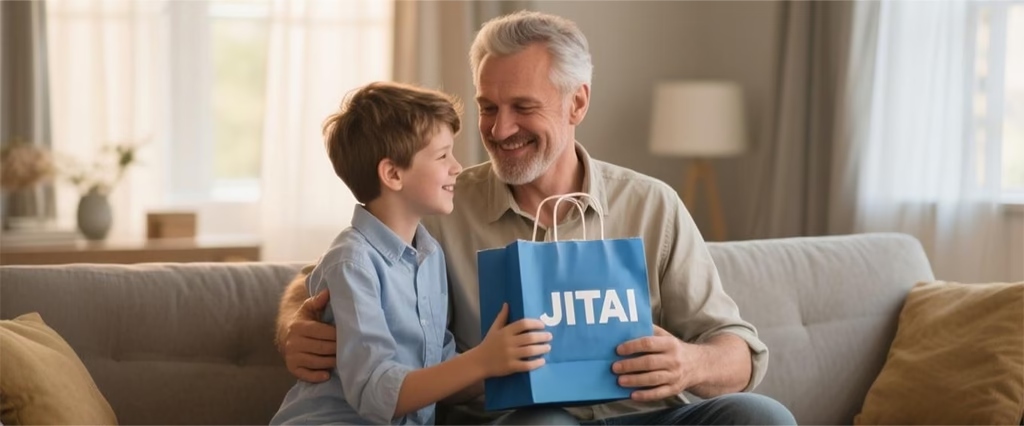Step away from the novelty mug destined for the back of the cupboard. Take back the cliché tie that will join its forgotten brethren in the closet. This year, U.S. consumers are looking past the predictable, seeking to give Father’s Day gifts imbued with genuine meaning. They’re on a mission to find items that reflect a father’s unique personality and capture a heartfelt sentiment—and jewelry designers and retailers are eagerly meeting the moment.
The new currency in men’s jewelry is individuality. “The biggest trends are pieces that feel distinctly personal: unique bands, meaningful symbols, and custom medallions,” says Ann Grimmett, vice president of merchandising for the major jewelry retailer Jared. She anticipates a surge in sales of items that blend timeless materials like yellow and white gold with modern textures. “Think classic silver chains paired with rich leather cords, or precious metals accented with earthy beads,” she explains.
This isn’t just a hunch from retailers. The desire for authenticity is a sentiment echoed by shoppers themselves. A recent Father’s Day gifts survey by the National Retail Federation (NRF) revealed that the single most important factor for buyers is finding a gift that is “unique or different,” followed closely by one that “creates a special memory.”
“Men are looking for pieces they can wear every day, that transition seamlessly from the office to a weekend barbecue,” Grimmett adds. “They want something that feels like it was made for them, or at least has an element of personalization that tells their story.”
Even a perennially popular gift like a wristwatch, she notes, is being re-imagined through this personal lens. “It all depends on his style. A classic dad might cherish a timeless timepiece on a supple leather strap, while another might prefer the rugged sophistication of a dive or racing watch with intricate details,” Grimmett says. “We’re also seeing a huge trend toward pops of color on the dial—a flash of emerald green or deep ocean blue can completely transform a watch’s character.”
Perhaps no brand captures this spirit of storytelling better than the Detroit-based Rebel Nell. While golf-themed accessories are a Father’s Day staple, Rebel Nell has debuted a limited-edition collection that offers a tangible piece of sporting history. The pieces are crafted from material repurposed from the actual caddie bibs worn during the Rocket Classic, Detroit’s annual PGA Tour golf tournament.
“At Rebel Nell, we believe in giving new life to meaningful materials, and there’s something so special about these bibs,” says Amy Peterson, the company’s co-founder and CEO. “They are history; they’ve been part of pivotal tournament moments. Now they’re part of a new story, one that supports women as they rewrite their futures.”
The collection—featuring necklaces, bracelets, cufflinks, and even divot tools—is made in Detroit by women overcoming barriers to employment. Each item is meticulously crafted to preserve the original texture, color, and character of the caddie bib, celebrating the energy and camaraderie of the game.
This groundswell of sentiment is making a powerful impact on wallets. Father’s Day spending is projected to reach an all-time high of $24 billion this year, according to the NRF’s survey (conducted with Prosper Insights & Analytics), eclipsing the $22.4 billion spent in 2024 and $22.9 billion in 2023.
“As consumers look to recognize the father figures in their lives, retailers are prepared with gift ideas, special deals, and convenient shopping options to help customers find the right gifts,” said Katherine Cullen, NRF’s vice president of industry and consumer insights.

On average, consumers plan to spend $199.38 per person, nearly $10 more than last year. The charge is being led by shoppers aged 35 to 44, who are spending the most of any age group at an average of $278.90—a significant $27 increase from last year.
These meaningful gifts are being purchased for a wide circle of father figures. While nearly half (48%) are shopping for a father or stepfather and a quarter for a husband, many are also buying for sons (12%), brothers (9%), friends (8%), and grandfathers (6%). And just as in previous years, online retailers remain the top destination (41%), followed by department stores (35%) and a mix of discount, specialty, and local small businesses.
Ultimately, this trend signifies more than just a change in product preference. It’s a deeper evolution in how we celebrate fatherhood—a move away from the obligatory and disposable, and toward the personal and permanent.



